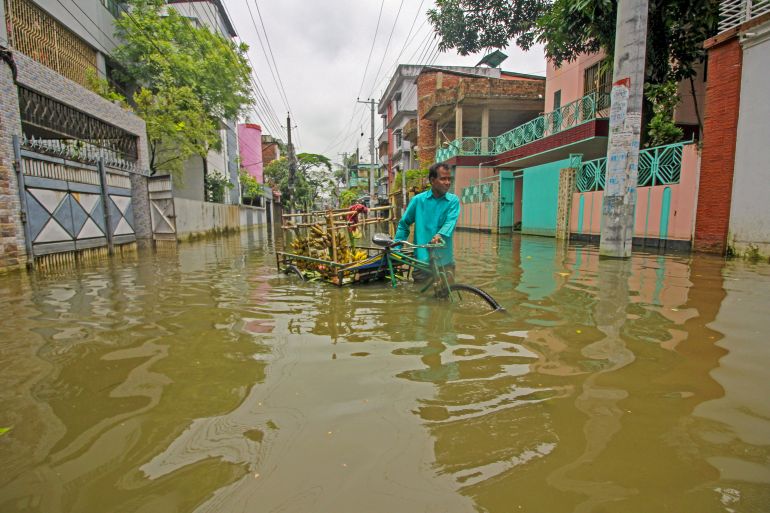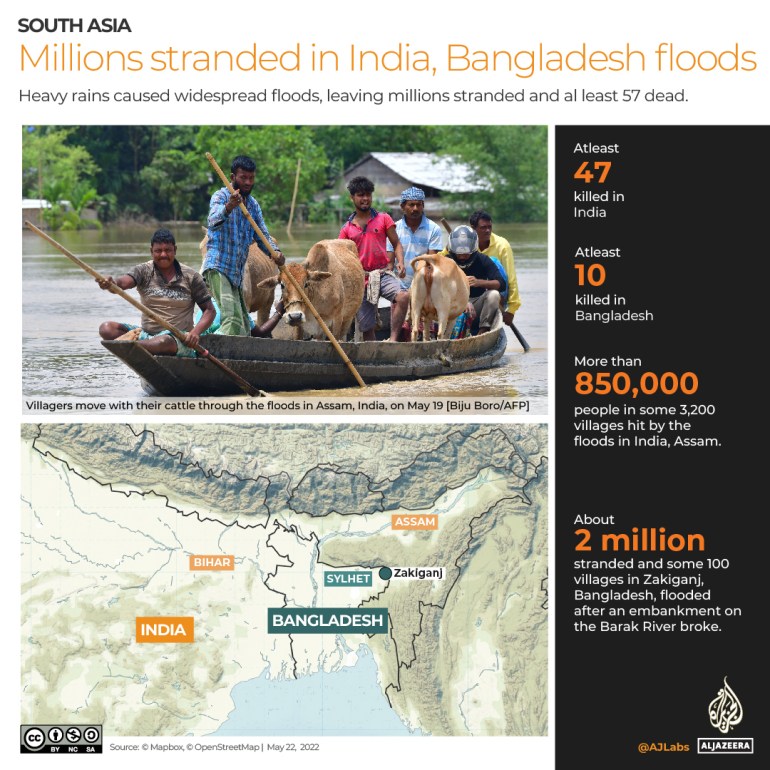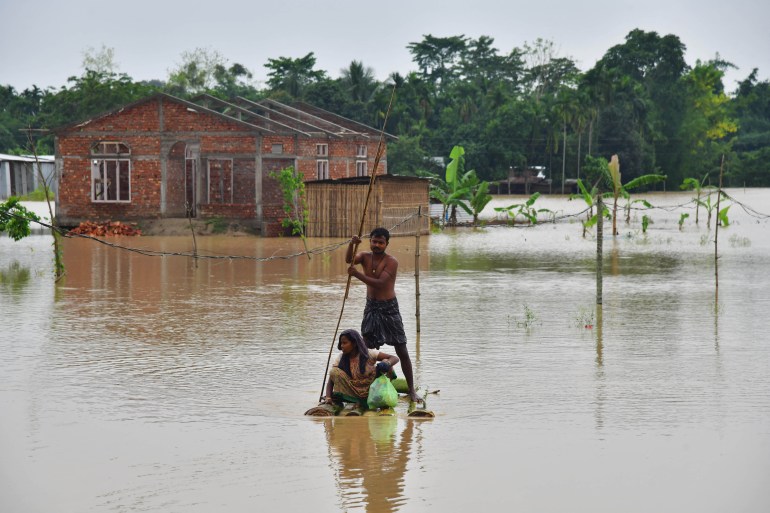Millions stranded as flooding causes havoc in Bangladesh, India
Nearly 60 people killed and about three million people affected by flooding in Bangladesh and India.

Heavy rains have caused widespread flooding in parts of Bangladesh and India, leaving millions stranded and at least 57 dead, officials have said.
In Bangladesh, about two million people have been marooned by the worst floods in the country’s northeast for nearly two decades while nearly one million people have been affected by the flooding.
Keep reading
list of 4 items‘Catastrophic’ Durban floods leave trail of death and destruction
Death toll from South Africa’s Durban floods rises to 341
Death toll from Philippines landslides, floods reaches 115
At least 100 villages at Zakiganj were inundated after floodwater rushing from India’s northeast breached a major embankment on the Barak River, said Mosharraf Hossain, the chief government administrator of the Sylhet region.

“Some two million people have been stranded by floods so far,” he told AFP, adding that at least 10 people have been killed this week.
Many parts of Bangladesh and neighbouring regions in India are prone to flooding, and experts have said that climate change is increasing the likelihood of extreme weather events around the world.
Every extra degree of global warming increases the amount of water in the atmosphere by about 7 percent, with inevitable effects on rainfall.
At least 47 people have been killed in India this week in days of flooding, landslides and thunderstorms, according to local disaster management authorities.
In Assam state, which borders Bangladesh, at least 14 people have died in landslides and floods.
Assam authorities said on Saturday more than 850,000 people in about 3,200 villages have been affected by the floods, triggered by torrential rains that submerged swaths of farmland and damaged thousands of homes.
Nearly 90,000 people have been moved to state-run relief shelters as water levels in rivers run high and large swathes of land remain submerged in most districts.
‘We don’t have enough to eat’
Al Jazeera’s Pavni Mittal reporting from central Assam said the Hojai district has been one of the worst affected areas.
“Receding water levels are making it more difficult to evacuate people … The water in some parts is estimated to be at least 15 feet deep (4.6 metres),” Mittal said.
“[The rescue boats are] retrieving bodies, carrying relief material and rescuing stranded villagers who have been stuck without food and other necessities for days.”
The dozens of families that have been staying at a relief camp in Hojai said that they need more help from the government, Mittal said.
“We worry about our future. We don’t know what we will do. We don’t think there’s any hope for us,” Rahima Khan told Al Jazeera.
“We have left our cattle and we don’t have enough to eat. We have been here for a while and we are still waiting for help.”
At least 33 people were killed in eastern Bihar state in thunderstorms on Thursday.
More than three dozen people were injured in the unseasonal weather events that damaged hundreds of hectares of standing crops and thousands of fruit trees.
Bihar has also suffered an intense heatwave this week, with temperatures reaching 40 degrees Celsius (104 degrees Fahrenheit).

‘Blessing and curse’
In Bangladesh’s Zakiganj, people were seen fishing on submerged roads and some residents took their cattle to flood shelters.
Bus driver Shamim Ahmed, 50, told AFP, “My house is under waist-deep water. There is no drinking water, we are harvesting rainwater.
“Rain is simultaneously a blessing and a curse for us now.”
All the furniture in widow Lalila Begum’s home was ruined, she said, but she and her two daughters were staying put, hoping the waters would recede within a day or two.
“My two daughters and I put one bed on another and are living on top of it,” she said. “There’s a scarcity of food. We’re sharing one person’s food and one meal a day.”
Floodwater has entered many parts of Sylhet city, the largest in the northeast, where another official told AFP about 50,000 families had been without power for days.
Hossain, the chief administrator, said the flooding was driven by both rains and the flow of water from across the border in India’s northeastern state of Assam.